The Great Inversion
For two decades, Google occupied the vast middle of the productivity spectrum, from initial information discovery through research, synthesis, and task execution.
My argument in this analysis is to demonstrate how Google has already become a task completion companion to AI systems, handling the narrow yet persistent edges of digital tasks.
These aren't searches moving to AI (as I'll show you the concept that a "search" is like an "AI prompt" is, per se, quite misleading). What AI handles are complex tasks that search could never properly handle, and are now finding their natural home.
It's important to publish this sort of analysis, at this stage, to counteract some new analyses that are coming out, that want to prove AI is just buzz, and almost saying "Google isn't going anywhere, nor is it changing at all, if at all, AI is making Google more used."
This is evident in the "quantitative data," but as I'll explain further in the analysis, this data is cherry-picked. It misses a key point: while AI chatbots like ChatGPT are driving up the usage of Google search, they are also fundamentally changing what Google is used for, and the role of Google itself within the digital ecosystem.
Let’s break it down, step by step.
Repeat with me: a search is not a prompt! - Quantifying the Task Migration
First of all, I want to start by making sure we trace and remark the difference between a search and a prompt.
Qualitatively, these are two different things.
A search is a task part of a productivity spectrum where a user is trying to find information to perform a task. It implies that the user goes in and out of a search engine to a web page, finding more and more relevant pieces of information that help them achieve their desired goal.
Instead:
On the other hand, a prompt is something else. It's a short or long command you give the AI to achieve a whole task, with the goal of the AI chatbot to complete the task you're giving it. It can happen that a prompt doesn't complete the whole task (e.g., you're not sure the source mentioned by the AI is correct, so you need to cross-reference), but it often does, rather than not. And that's the key point, as AI chatbots turn into AI agents, their goal will be more and more to complete the whole task.
From here, we have a simple derivation: a session in the search world is not the same thing as a prompt in the AI world!
Keep that in mind.
The Replacement Ratio
Let’s now examine another key qualitative aspect: how, each time a user uses it, this is eroding traditional Google search behavior to transform it into something else.
Of course, this qualitative change will always be stronger for younger generations (they’ll find the new AI-first behavior natural) while slower for older generations (the laggards of today might never adopt AI in full, but the laggards of tomorrow will).
While direct measurement remains elusive, multiple data points support a 10-20x task replacement ratio:
Session Length Analysis: ChatGPT sessions average 7-13 minutes (ranging from 7:19 to 13:58 minutes across various 2025 studies), as reported by Digital Information World and Keywords Everywhere, during which users engage in sustained problem-solving. Comparable Google research sessions involve much shorter timeframes, with the average Google search session lasting just 76 seconds, and half of all search sessions finishing within 53 seconds, as reported by Sixth City Marketing.
Query Complexity Differential: The average length of a search query in the U.S. is 3.4 words, as reported by Semrush, while ChatGPT prompts contain significantly more information density and conversational context retention. Combined with conversational context retention, each ChatGPT session contains the informational equivalent of dozens of fragmented Google searches.
Where Google Remains Essential (For Now - Before Consumer AI Agents Become The Norm)
Will Google search
Where does Google remain dominant, and what are its strongholds (for now)?
Transactional queries (shopping, booking, purchasing)
Local searches ("near me" queries, business hours, directions)
Real-time information (breaking news, sports scores, stock prices)
Quick factual lookups (requiring under 30 seconds)
These represent high-frequency but low-complexity tasks—the "completion companion" role that generates volume but not depth.
This simple evaluation above tells you how Google itself is fundamentally changing.
The Business Model Crisis: Death by a Thousand Cuts
Now that we've addressed the elephant in the room, let's look at this from a business model perspective.
By 2025, 58.5% of Google searches in the U.S. and 59.7% in the EU result in zero clicks, as reported by SparkToro and Search Engine Land. Clicks to organic search results are down, with only 40.3% of U.S. Google searchers clicking on an organic result in March 2025, down from 44.2% the prior year, as reported by Search Engine Land.
This creates a vicious cycle:
Google serves more zero-click answers to remain competitive with AI
Publishers receive less traffic and create less content
Content quality degrades, making AI summaries more attractive
Users rely more on AI-generated overviews
The open web continues shrinking
In March 2025, 27.2% of U.S. searches ended without a click compared to 24.4% in March 2024, while 14.3% of U.S. Google searches resulted in clicks on other Google-owned properties (e.g., YouTube, Maps), compared to 12.1% a year ago, as reported by Search Engine Land.
Google's search advertising model depends on multiple touchpoints and choices. A search results page offers 3-4 ad slots plus shopping results. An AI conversation offers a single response with nowhere to place comparable ad inventory.
The Demographic Destiny Hidden in the Data
The Generational Replacement
As of 2025, ChatGPT has 800 million weekly active users, processing over 1 billion queries per day, according to DemandSage.
But age segmentation reveals the real story.
According to multiple surveys conducted in 2025, young adults are leading the adoption of AI.
70% of Gen Z users utilize generative AI, such as ChatGPT, every week, and most importantly, 52% trust AI to help them make decisions
In comparison, 56% of young adults (ages 18-24) are the most active users of generative AI, followed by millennials, as reported by TheySaid and Technology Record.
The most striking statistic there is that 58% of these millennials 58% say AI will change their daily lives.
Nearly half (45%) of Baby Boomers have used AI in the past six months.
This isn't adoption slowing—it's generational replacement in progress. While Gen Z leads overall AI adoption as expected, Millennials (ages 29-44) emerge as power users, reporting more daily usage—flipping the typical "younger = higher usage" pattern, as reported by Menlo Ventures.
The Enterprise Blindspot
ChatGPT is used by 92% of Fortune 100 companies, as reported by NerdyNav.
When OpenAI reports massive growth while consumer clickstream shows plateauing, the difference is in the enterprise.
If Boeing or Goldman Sachs deploys ChatGPT internally, that's millions of API calls but zero additional "users" in consumer usage data.
The Expansion Hypothesis: A Comforting Delusion
Research shows that 50% of Google users click on their results within 9 seconds of searching, and the average amount of time it takes a Google searcher to click on something is 14.6 seconds, as reported by Backlinko.
But consider what these searches increasingly are:
Verification queries - "Is this ChatGPT answer accurate?"
Implementation searches - "Buy X that ChatGPT recommended"
Clarification lookups - "What does this term ChatGPT used mean?"
These aren't independent searches—they're subordinate to the AI session. Google has become the fact-checker and transaction layer for AI-generated insights.
That's the definition of a companion tool, not a primary platform.
The Inescapable Conclusion
The data confirms that Google's transformation from a broad task engine to a narrow task companion is already complete for high-value work:
Complex research and analysis → AI (ChatGPT sessions: 7-13 minutes)
Content creation and synthesis → AI (70% of prompts non-search)
Learning and exploration → AI (sustained conversational engagement)
Quick lookups and transactions → Google (76-second sessions maintained)
Can Google's business model survive this transformation? The math suggests not in its current form:
Advertising revenue requires multiple touchpoints that AI eliminates
Cost structure increases 10x with AI integration
Publisher ecosystem collapse undermines content quality
Generational replacement ensures trend acceleration
The data showing that only 360 out of every 1,000 Google searches in the US result in clicks to non-Google properties, as reported by SparkToro, provides false comfort.
Volume without value is just activity.
When the highest-value tasks happen elsewhere, when publishers stop creating content, when young users never develop search expertise—the business model breaks even if the usage metrics look stable.
Google’s team knows this well, and that is why the search engine might, in 3-5 years, transform and transition mostly to AI Mode.
The alternative isn't death but irrelevance: becoming the Yahoo of the 2030s, profitable but no longer definitional to the internet.
The great inversion has already happened in task value. The business model inversion is next.
The only question is whether Google can manage its own transformation or whether the market will do it for them.
Recap: In This Issue!
Core Argument
Google once spanned the full productivity spectrum (discovery → research → synthesis → execution).
AI now absorbs the high-value, complex tasks Google never fully managed, relegating Google to the task completion companion role.
Search ≠ Prompt: a session in Google ≠ a task in AI.
Search vs. Prompt
Search: fragmented info retrieval → user pieces together answers.
Prompt: AI executes or completes full tasks → fewer fragments, more outcomes.
Each AI session = dozens of Google searches in value.
The Replacement Ratio
AI sessions: 7–13 minutes (sustained, complex).
Google sessions: 76 seconds average, half end in <53 seconds.
Search queries: ~3.4 words; AI prompts are denser, contextual, and sustained.
Estimated 10–20x replacement ratio (one AI session replaces dozens of searches).
Google’s Current Strongholds
Transactional queries (shopping, booking, purchases).
Local lookups (“near me,” directions, hours).
Real-time info (news, sports, stocks).
Quick factual checks (<30 seconds).
These are low-complexity, high-volume tasks—not high-value work.
Business Model Crisis
58–60% of searches = zero clicks (SparkToro, Search Engine Land).
Organic clicks declining (40.3% in Mar 2025 vs. 44.2% in 2024).
Google-owned properties (YouTube, Maps) capture rising share.
Problem:
Ads depend on multiple touchpoints, but AI condenses to single response.
More zero-click results → publishers earn less → content quality degrades → AI overviews look better → reliance on AI grows.
Demographic Shift
ChatGPT: 800M weekly users, 1B+ queries/day (DemandSage).
70% of Gen Z use AI weekly; 52% trust it for decisions.
Millennials = power users, with more daily use than Gen Z.
Nearly half of Boomers tried AI in past 6 months → generational replacement in progress.
Enterprises (92% of Fortune 100 using ChatGPT) drive massive unseen adoption via APIs.
The Expansion Myth
Rising Google usage = misleading. Many searches are AI-dependent queries:
Verification (“is ChatGPT right?”).
Implementation (“buy X AI recommended”).
Clarification (“term AI used”).
Google is increasingly subordinate to AI sessions, not independent.
Inescapable Conclusion
AI owns high-value tasks: research, content, exploration.
Google owns low-value tasks: quick checks, transactions.
Business model risks:
Ad revenue compression (fewer touchpoints).
Higher compute costs (AI integration).
Content supply collapse (fewer incentives for publishers).
Generational replacement (young users skip “search literacy”).
Result:
Google’s future = transition to AI Mode in 3–5 years.
Alternative: profitable but irrelevant (the Yahoo path).
The inversion has already happened in task value; business model inversion is next.
With massive ♥️ Gennaro Cuofano, The Business Engineer


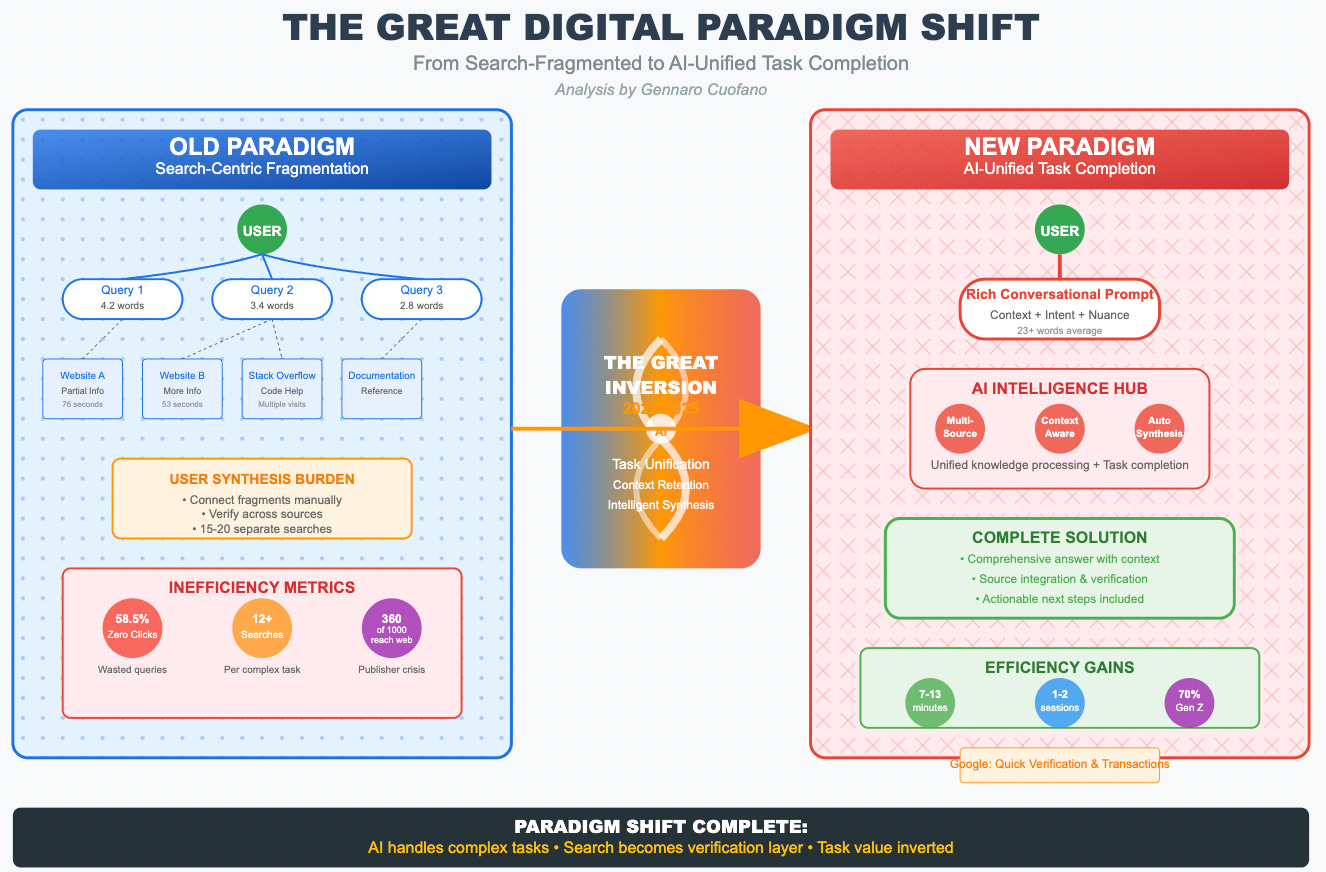
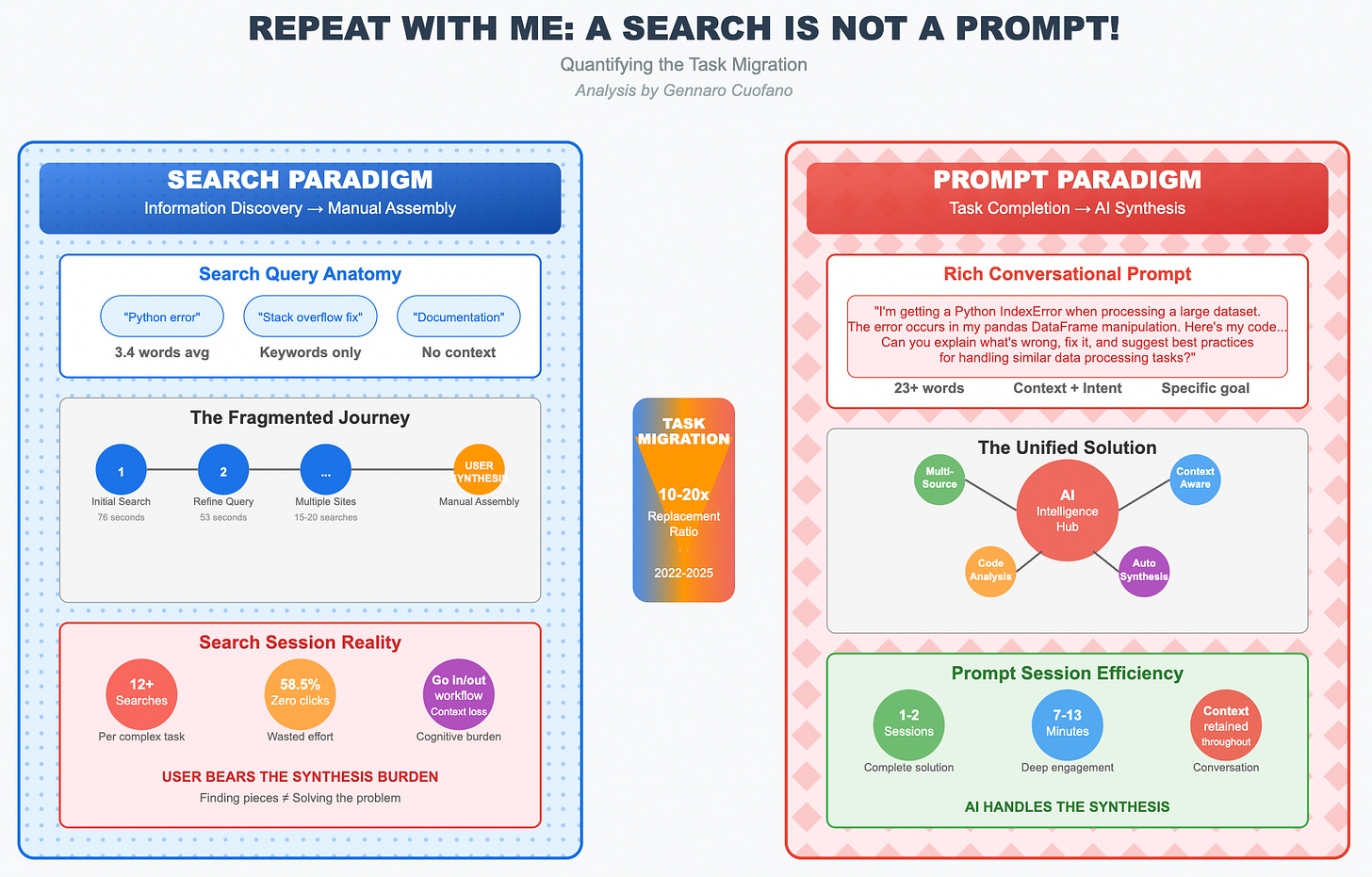
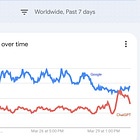
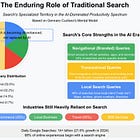
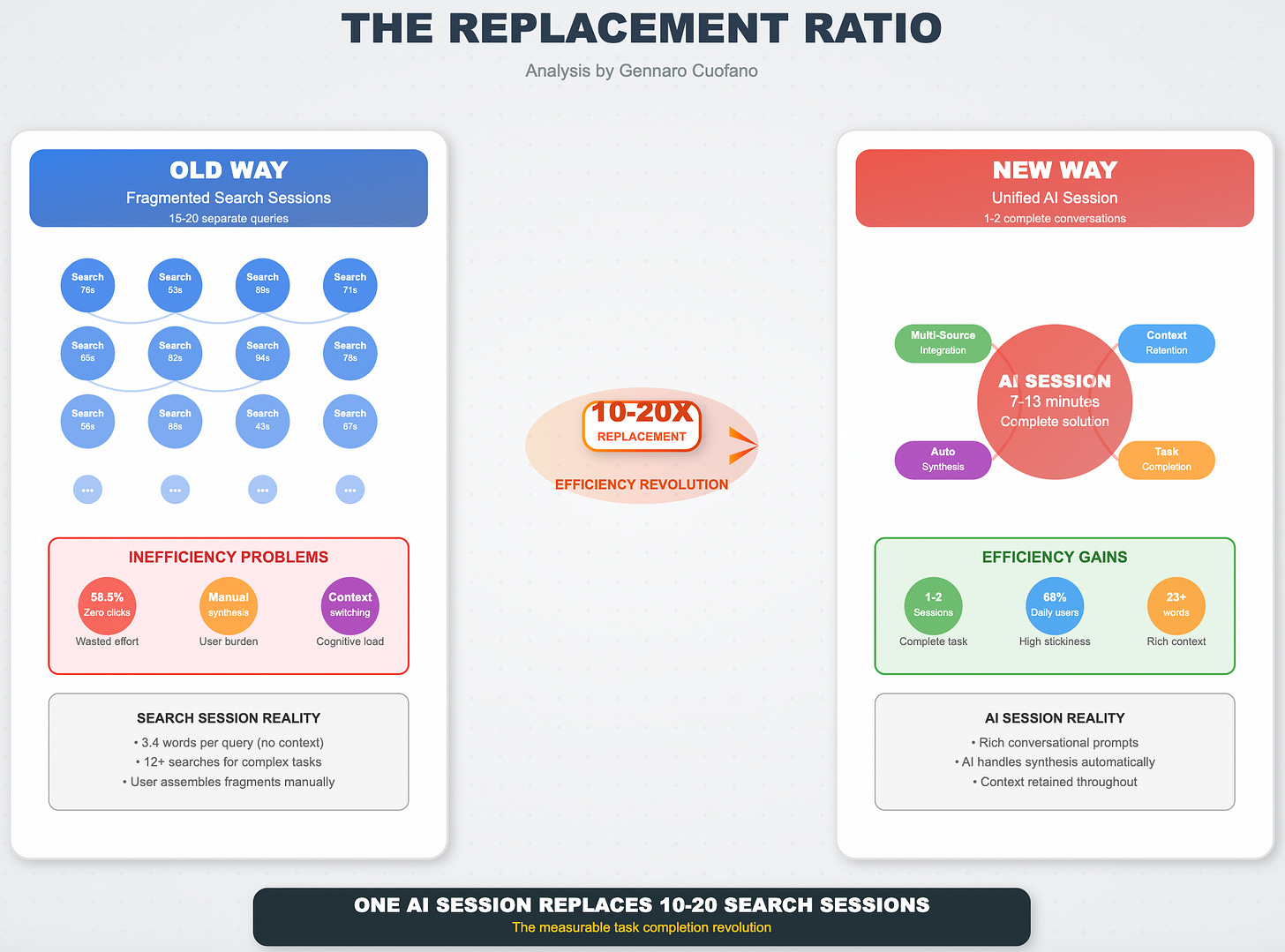
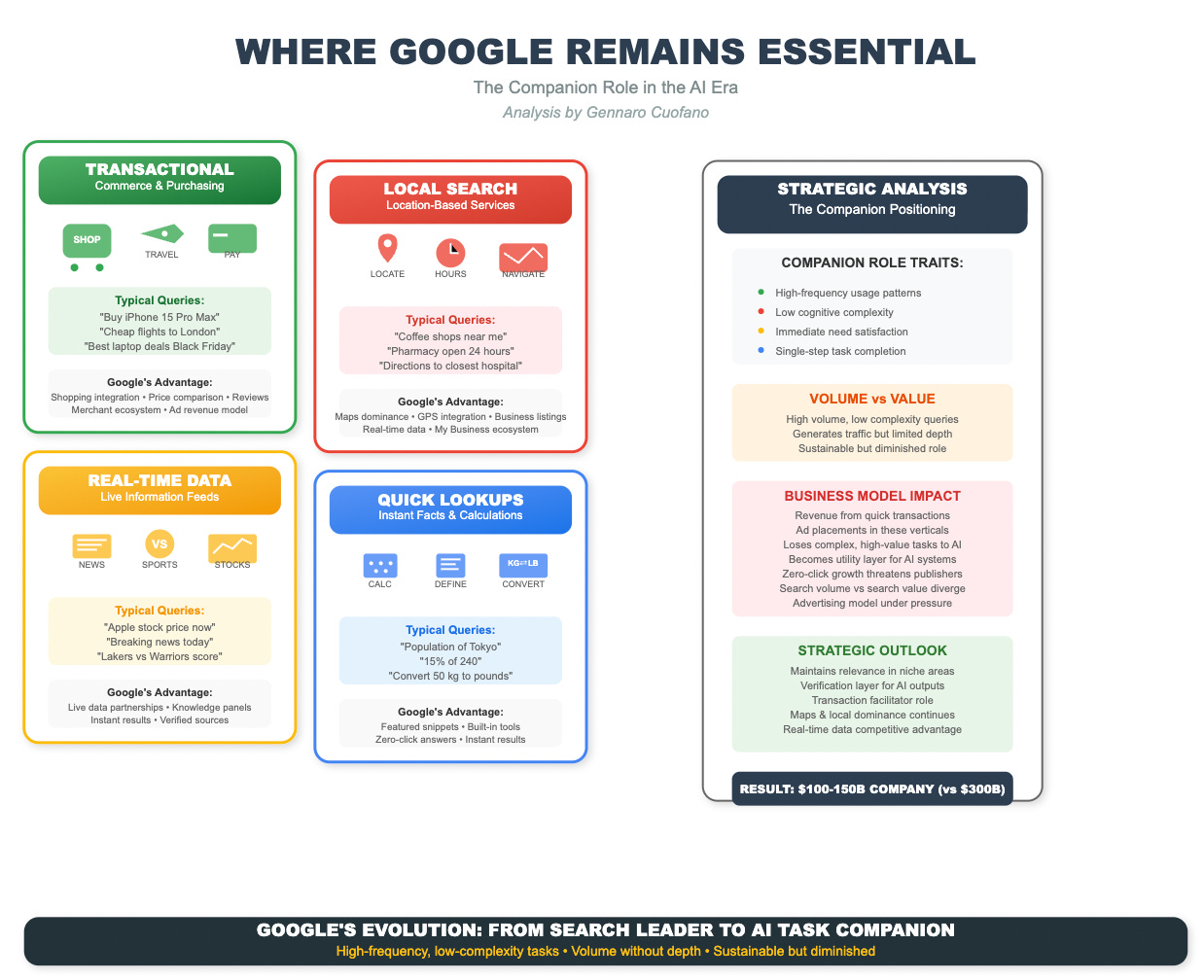


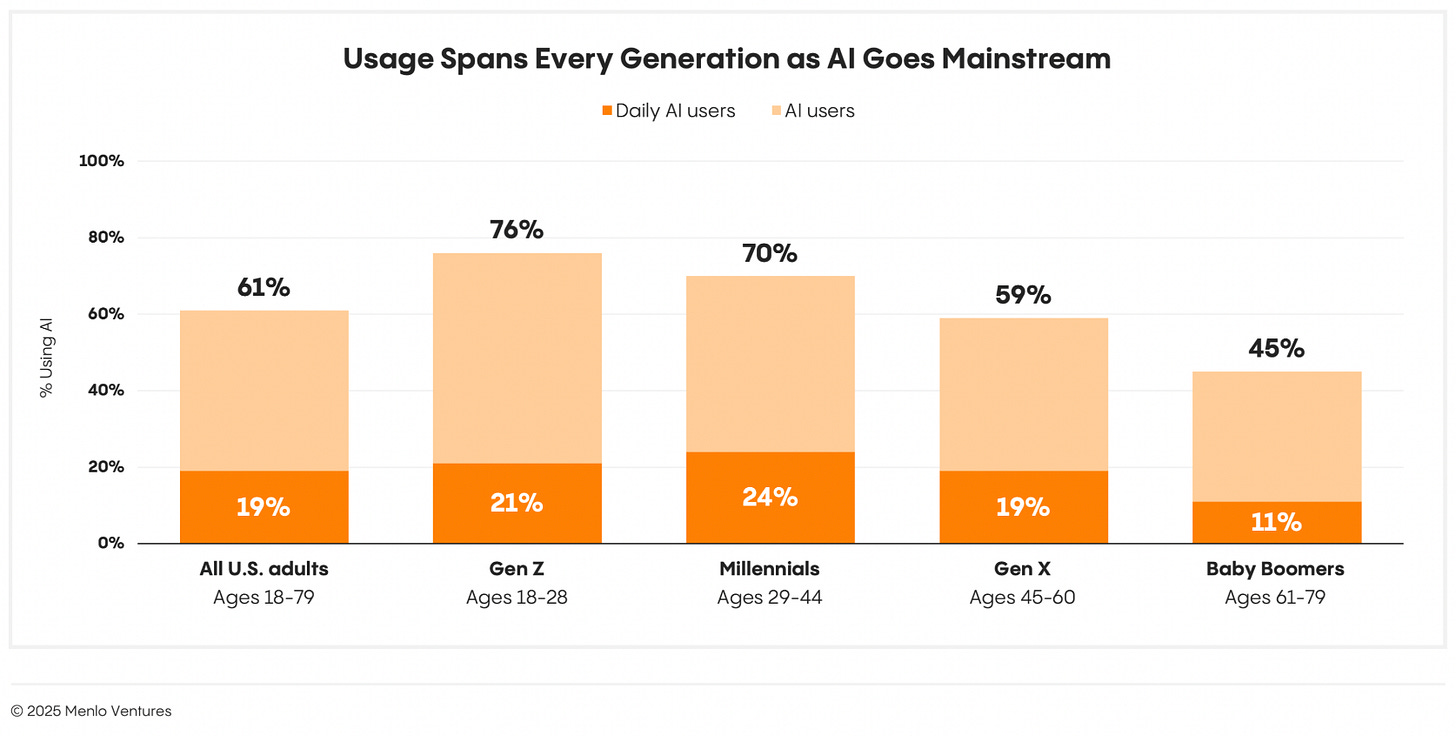
More precisely, a properly written prompt is not the same as a Google search. Unfortunately, many people still write prompts the way they would type a search in Google—even after training. Perhaps in an article (maybe you’ve already done this) you could share some of your own secrets for effective prompting.
A new day, another great article. My key insight is that, while many say the real business use of AI starts with processes (cost optimization, CJM, and CX), it actually begins with understanding that AI is crucial for disrupting existing business models and creating new ones—enabling small companies to achieve even bigger breakthroughs than we’ve seen so far, as with Netflix, Dollar Shave Club, and others. In short, AI enables disruption on steroids.